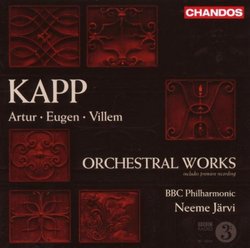| All Artists: Artur Kapp, Eugen Kapp, Villem Kapp, Neeme Järvi, BBC Philharmonic Orchestra Title: Kapp Family Orchestral Works Members Wishing: 0 Total Copies: 0 Label: Chandos Original Release Date: 1/1/2008 Re-Release Date: 1/15/2008 Genre: Classical Style: Symphonies Number of Discs: 1 SwapaCD Credits: 1 UPC: 095115144121 |
Search - Artur Kapp, Eugen Kapp, Villem Kapp :: Kapp Family Orchestral Works
 | Artur Kapp, Eugen Kapp, Villem Kapp Kapp Family Orchestral Works Genre: Classical
|
Larger Image |
CD Details |
CD ReviewsObscure, but interesting, symphonic music from Estonia Russ | Richmond, VA | 01/20/2008 (5 out of 5 stars) "Artur Kapp (1878-1952), and Rudolf Tobias are seen as the co-founders of the symphonic tradition in Estonia. Artur's son, Eugen (1908-1996), and nephew, Villem (1913-1964) were composers in their own right. This release contains three disparate works by the three Kapps, but each is engaging in its own way. The heavy use of minor tonalities within Artur Kapp's Don Carlos overture (1899) gives the work a dramatic tone. This is a highly romantic, tempestuous, work, filled with lots of orchestral swells, cymbal crashes and accented chords. The work's underlying melody eluded me; however identifying all of the similarities between Kapp's overture and the orchestral works of Tchaikovsky has provided me with much entertainment. Eugen Kapp's 'Kalevipoeg' Ballet Suite (1947) contains six delightfully rustic dance pieces. The earthy opening dance (Track 2), containing an infectious staccato motif, is especially charming. The remaining dances seem to borrow heavily from other composers, ranging from Sibelius to Copland. The 'Forging of the Swords' dance (Track 4), as an example, has an undeniable 'American frontier' flavor about it. Despite the wide ranging influences, the suite on the whole is quite enjoyable. The most compelling composition on this release is Villem Kapp's Symphony No. 2 in C minor (1955). The work is heavily steeped in the nineteenth-century symphonic tradition, so listeners won't find anything too audacious here. But there's still a lot to like. The symphony is unified by a powerful four note motif. This motif propels the opening movement along a stormy path that culminates with a fiery coda. The dark and boisterous tone of this movement gives the work a distinctive Nordic character. The second movement contains a lush melody, whose melancholic charm will certainly stay with you after the music has ended. I especially enjoy the aggressive finale, which contains shades of Shostakovich. The work's conclusion, filled with brass and percussion, is completely over the top, but it certainly is exciting. The overture and the ballet suite do seem a bit derivative, but are delightful nonetheless. Villem's powerful symphony, in my opinion, certainly deserves more attention than what it has received. As a final consideration, the BBC Philharmonic, under Neeme Järvi, delivers a very enthusiastic performance of these works. And, of course, the sound quality is outstanding. Recommended to obscure music enthusiasts! TT: 63:34" Happy Prospecting for Obscure Estonian Composers Mr. Louis Blois | New York | 01/17/2008 (4 out of 5 stars) "The adventurous spirit will be rewarded with this very appealing survey of the music of Estonia's celebrated Kapp family. The patriarch, Artur (1878-1952), graduated from the St Petersburg Conservatory in 1900, his son Eugen (1908-96) and nephew Villem (1913-64) from the Tallin Conservatory in 1931 and 1947 respectively. Each was influential in establishing a symphonic tradition in Estonia in the first half of the 20th Century. Each writes in a tonal, ingratiating post-Romantic style. But it isn't just this bit of historical trivia that earns this disc 4 out of 5 stars.
Of the three pieces on the album I was most impressed with Villem Kapp's Second Symphony of 1955. Villem, more so than his cousin and uncle in their works represented on this disc, had a knack for writing good memorable tunes. He also treats them with enough quirky exuberance to make an individual mark for himself. After a slow introduction, a jaunty little 4-note theme dances to its heart's content and is met with a flowing second theme whose stately grace will bring to mind the music of Sir Edward Elgar. The development is not the most rigorous. Yet Villem brings enough lyrical inventiveness to the meeting of these two ideas to keep the symphonic engines running convincingly. The slow movement ingratiates with its lovely tune, which is brought to a number of energetic peaks. The Scherzo and the finale again show Villem's irrepressible lyrical enthusiasm. "Papa" Artur Kapp's "Don Carlo Overture" (1899) offers a lot of well-crafted, high Romantic melodrama. To call the Kalevipoeg Suite (1947) of Eugen Kapp 'Sibelian' would be to flatter it a wee bit much. Yet good amiable ballet music it is, with a pronounced folk character. I was delighted to make the musical acquaintance of all three Kapps, whose works are lovingly interpreted by fellow countryman Nemee Jarvi. Bonus: photo portrait of all three composers in the CD booklet plus informative liner notes by David Fanning. How can you go wrong?" |

 Track Listings (11) - Disc #1
Track Listings (11) - Disc #1